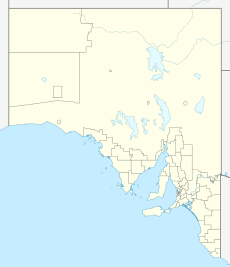world.wikisort.org - Australia
Nantawarra is a locality in South Australia located about 120 kilometres (75 miles) north of the Adelaide city centre and within the local government area known as the Wakefield Regional Council.[4][5][6] The locality occupies land on both sides of Highway 1 between Port Wakefield in the south and Snowtown in the north.[3] Nantawarra is recognisable from a distance by the presence of grain silos immediately just east of the Adelaide-Port Augusta railway line.[citation needed] The name Nantawarra may derive from the word nantuwara (meaning a northern yerta, or family group) in Kaurna, the language of the indigenous people of this part of South Australia.[citation needed]
| Nantawarra South Australia | |||||||||||||||
|---|---|---|---|---|---|---|---|---|---|---|---|---|---|---|---|
 View of Nantawarra's silos from Highway 1, facing east | |||||||||||||||
 Nantawarra | |||||||||||||||
| Coordinates | 34°01′23.1″S 138°13′35.6″E | ||||||||||||||
| Population |
| ||||||||||||||
| Postcode(s) | 5550 | ||||||||||||||
| Location |
| ||||||||||||||
| LGA(s) | Wakefield Regional Council | ||||||||||||||
| State electorate(s) | Narungga[2] | ||||||||||||||
| Federal division(s) | Grey | ||||||||||||||
| |||||||||||||||
Traditional occupants
According to the Manning Index of South Australian History the "Nantuwwara [sic] tribe of some 25 to 30 once occupied the country from the River Wakefield, north to Whitwarta and west to Hummock Range", an area which would encompass the modern localities of Bowmans, Whitwarta, Goyder, Beaufort, Nantawarra and Mount Templeton. The term Nantuwara (or Nantuwaru) is considered to be a specific name for the northern hordes of the Kaurna people.[7] Stone implements thought to have been used by the Nantuwara people were discovered at sites adjoining the banks of the lower reaches of the River Wakefield and added to a South Australian Museum collection curated by Harold Cooper in the 1960s.[8]
See also
- List of cities and towns in South Australia
- Railway accidents in South Australia
- Yorke Peninsula Field Days
References
- Australian Bureau of Statistics (28 June 2022). "Nantawarra (Suburbs and Localities)". Australian Census 2021 QuickStats. Retrieved 28 June 2022.
- Narungga (Map). Electoral District Boundaries Commission. 2016. Retrieved 1 March 2018.
- "Wakefield Regional Council Map" (PDF). Wakefield Regional Council. Archived from the original (PDF) on 3 March 2016. Retrieved 16 May 2015.
- "Wakefield Regional Council". Local Government Association of South Australia. Retrieved 15 May 2015.
- "Suburbs and rural localities list" (PDF). Department of Planning, Transport and Infrastructure. Retrieved 16 May 2015.
- "Search result for "Nantawarra" (Record ID SA0048633)". Geoscience Australia. Retrieved 16 May 2015.
- Manning, Geoffrey. "Place names: Nantawarra". Manning Index of South Australian History. State Library of South Australia.
- Cooper, H.M. (1961). "Archaeological stone implements along the lower River Wakefield, South Australia". Transactions of the Royal Society of South Australia. 34: 105–118.
Другой контент может иметь иную лицензию. Перед использованием материалов сайта WikiSort.org внимательно изучите правила лицензирования конкретных элементов наполнения сайта.
WikiSort.org - проект по пересортировке и дополнению контента Википедии